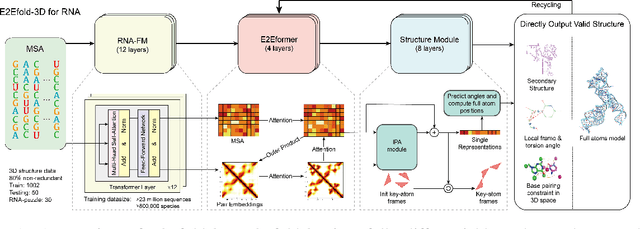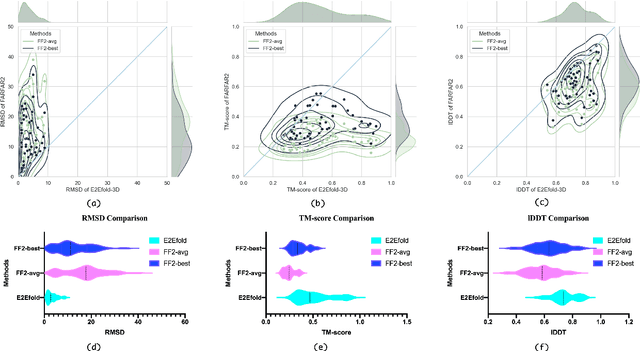Liangzhen Zheng
E2Efold-3D: End-to-End Deep Learning Method for accurate de novo RNA 3D Structure Prediction
Jul 04, 2022



Abstract:RNA structure determination and prediction can promote RNA-targeted drug development and engineerable synthetic elements design. But due to the intrinsic structural flexibility of RNAs, all the three mainstream structure determination methods (X-ray crystallography, NMR, and Cryo-EM) encounter challenges when resolving the RNA structures, which leads to the scarcity of the resolved RNA structures. Computational prediction approaches emerge as complementary to the experimental techniques. However, none of the \textit{de novo} approaches is based on deep learning since too few structures are available. Instead, most of them apply the time-consuming sampling-based strategies, and their performance seems to hit the plateau. In this work, we develop the first end-to-end deep learning approach, E2Efold-3D, to accurately perform the \textit{de novo} RNA structure prediction. Several novel components are proposed to overcome the data scarcity, such as a fully-differentiable end-to-end pipeline, secondary structure-assisted self-distillation, and parameter-efficient backbone formulation. Such designs are validated on the independent, non-overlapping RNA puzzle testing dataset and reach an average sub-4 \AA{} root-mean-square deviation, demonstrating its superior performance compared to state-of-the-art approaches. Interestingly, it also achieves promising results when predicting RNA complex structures, a feat that none of the previous systems could accomplish. When E2Efold-3D is coupled with the experimental techniques, the RNA structure prediction field can be greatly advanced.
tFold-TR: Combining Deep Learning Enhanced Hybrid Potential Energy for Template-Based Modeling Structure Refinement
May 30, 2021



Abstract:Protein structure prediction has been a grand challenge for over 50 years, owing to its broad scientific and application interests. There are two primary types of modeling algorithms, template-free modeling and template-based modeling. The latter one is suitable for easy prediction tasks and is widely adopted in computer-aided drug discoveries for drug design and screening. Although it has been several decades since its first edition, the current template-based modeling approach suffers from two critical problems: 1) there are many missing regions in the template-query sequence alignment, and 2) the accuracy of the distance pairs from different regions of the template varies, and this information is not well introduced into the modeling. To solve these two problems, we propose a structural optimization process based on template modeling, introducing two neural network models to predict the distance information of the missing regions and the accuracy of the distance pairs of different regions in the template modeling structure. The predicted distances and residue pairwise-specific deviations are incorporated into the potential energy function for structural optimization, which significantly improves the qualities of the original template modeling decoys.
 Add to Chrome
Add to Chrome Add to Firefox
Add to Firefox Add to Edge
Add to Edge